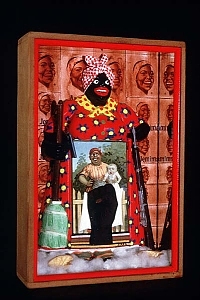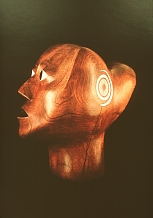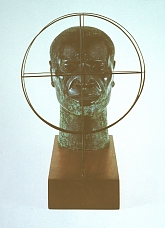
Betye Saar (African American, born 1926)
The Liberation of Aunt Jemima
1972, mixed media assemblage11 ¾" x 8" x 2 ¾"
 |
Betye Saar (African American, born 1926)The Liberation of Aunt Jemima1972, mixed media assemblage11 ¾" x 8" x 2 ¾" |
Some facts: Saar collects derogatory images of African Americans, now called Black Collectibles, as a way of understanding how Whites have historically defined Blacks—as caricatures, as objects, and sometimes as less than human. These manufactured images include Sambos, Toms, and Mammies, of which Aunt Jemima is a typical type. The Mammie, a Black female servant, usually depicted as fat, docile, and smiling, entered into popular culture before the turn of the century. As early as 1889 the fictional Aunt Jemima had become legendary through songs and was even portrayed in 1893 in the World’s Columbian Exposition in Chicago by a Black Kentucky cook who flipped over one million pancakes at that fair. Later this fictional Mammy became the logo on the box of a famous pancake mix. Saar reproduces this logo as the background "wallpaper" in her shallow box construction and uses one of the three-dimensional collectibles as the central figure in her "assemblage" (a kind of sculpture which combines various elements, some manufactured, or not created by the artist).
Since these images defined how Blacks were often perceived by Whites and were sometimes the source of how Blacks saw themselves, Saar thinks it is important to incorporate them in her art. The Mammie had a place (servant) and stayed in it. Saar liberates her.
Look carefully at this assemblage. What is the derogatory image like? Describe it. How has Saar liberated Aunt Jemima? What is she holding in her hands? Note too the picture in the carved out rectangle. What stereotype does it suggest? Aunt Jemima is a domestic image—but in whose home?
Although this sculpture was made in the early 1970’s, Saar has recently done a series of works, all using vintage washboards as the backdrop (the washboard was used for scrubbing clothes before the invention of the washing machine) and incorporating Mammie and other derogatory collectibles. This series is entitled "Women + Warriors: The Return of Aunt Jemima." She continues using this theme because she is "even more aware of the persistence of racism."
Elizabeth Catlett (African American, born 1915)left: Homage to My Young Black Sisters, 1968; center: The Black Woman Speaks, 1970; right: The Target, 1970 | ||
 |
 |
 |